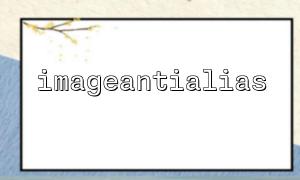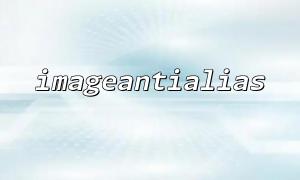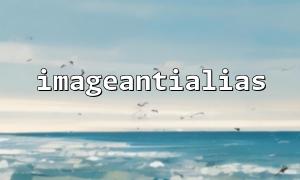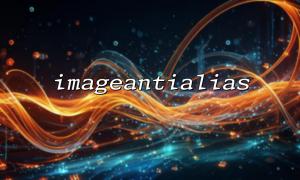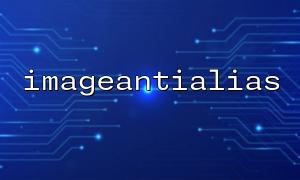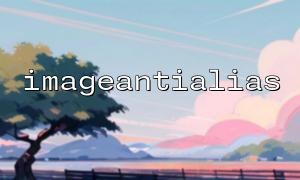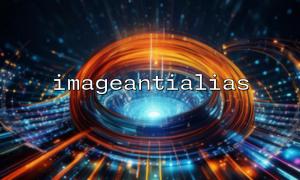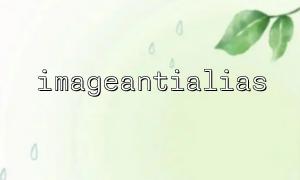When using PHP to process images, imageantialias() is a common function to enable anti-aliasing to improve image smoothness, especially when drawing lines or shapes. However, when many developers use this function to render images with text, they will find that the text is still jagged at the edges, which does not look smooth enough to achieve the ideal visual effect. Why is this? This article will explore in-depth the limitations of the imageantialias() function in PHP and the correct way to deal with text rendering.
imageantialias() is a function provided by the GD library. Its main function is to enable anti-aliasing function and improve the edge display effect of geometric figures such as lines and circles in the image. How to use it is as follows:
$image = imagecreatetruecolor(400, 200);
imageantialias($image, true);
After calling this function, perform drawing operations such as imageline() , imageellipse() , etc., and you will see that the edges are smoother. This is achieved through the image mixing algorithm inside the GD library.
The key problem is: imageantialias() is invalid for the text drawn by the imagettftext() function .
In the GD library, the drawing of text is done by the imagettftext() function, which renders text onto an image using the TrueType font file ( .ttf ). For example:
$font = '/path/to/font.ttf';
imagettftext($image, 20, 0, 50, 100, $color, $font, 'Hello World');
Although you call imageantialias() before drawing, the GD library does not perform additional anti-aliasing on the text output by imagettftext() . The anti-aliasing behavior of font rendering itself is controlled by the freetype library and has no direct relationship with imageantialias() .
When GD calls imagettftext() , its underlying dependency on the freetype library to render text, and freetype will enable its own anti-aliasing mechanism by default. This anti-aliasing mechanism is limited by GD's image type and color processing capabilities:
If you are using an image created by imagecreatetruecolor() (i.e., a 24-bit map), the text rendered by freestyle will have a certain anti-aliasing effect, but it is still not as smooth as vector graphics.
If you are using a palette image (8-bit) created by imagecreate() , the text basically does not have anti-aliasing capabilities.
So, if you find that text is jagged badly, first make sure you are using a truecolor image.
If you want to get a higher quality text rendering effect, you can try the following:
$image = imagecreatetruecolor(400, 200);
Truecolor images provide higher color depth and better support for anti-aliasing rendering.
One workaround is to draw text on a high-resolution image first and then shrink the image to achieve a smoothing effect:
$scale = 4;
$largeImage = imagecreatetruecolor(800, 400); // enlarge4Double
$color = imagecolorallocate($largeImage, 0, 0, 0);
imagettftext($largeImage, 80, 0, 200, 300, $color, $font, 'Hello');
$smallImage = imagecreatetruecolor(200, 100);
imagecopyresampled($smallImage, $largeImage, 0, 0, 0, 0, 200, 100, 800, 400);
header('Content-Type: image/png');
imagepng($smallImage);
imagedestroy($largeImage);
imagedestroy($smallImage);
This method simulates anti-aliasing effects by manually scaling the image, and the actual effect is often better than direct rendering.
GD itself has limited text rendering capabilities. If the image quality is high, it is recommended to use Imagick (based on ImageMagick):
$imagick = new Imagick();
$imagick->newImage(400, 200, new ImagickPixel('white'));
$draw = new ImagickDraw();
$draw->setFont('Arial');
$draw->setFontSize(20);
$draw->setFillColor(new ImagickPixel('black'));
$imagick->annotateImage($draw, 50, 100, 0, 'Hello World');
$imagick->setImageFormat('png');
header('Content-Type: image/png');
echo $imagick;
Imagick supports vectorized drawing and more detailed anti-aliasing, suitable for generating high-quality images.
Although imageantialias() is very effective when dealing with basic graphics, it does not affect the anti-aliasing effect of text rendering . Whether the text rendered using imagettftext() in PHP is smooth depends on the following factors:
Whether the image type is truecolor;
The quality of the font file itself;
Whether to use scaling optimization rendering;
Whether to use a more advanced image library such as Imagick.
After understanding these limitations, we can select tools and methods more targetedly to generate image output that meets our needs. If you encounter quality problems when building image verification codes, social media sharing pictures or text watermarks, you might as well start with these aspects to optimize.
For example, visit the following address to see the effects of image scaling optimization:
